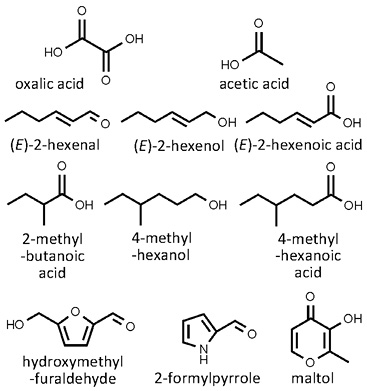 Rheum rhabarbarum
Rheum rhabarbarum
rhubarb
Back to “Salad herbs and herb mixtures: rhubarb (Rheum rhabarbarum)”
Back to “Culinary herbs: rhubarb (Rheum rhabarbarum)”
Rheum rhabarbarum L. (= R. ×hybridum Murray) (Polygonaceae); rabarber (Afrikaans); da huang (Chinese); rhubarbe (French); Rhabarber (German); rabarbaro (Italian); ruibarbo (Portuguese, Spanish)
DESCRIPTION Rhubarb leaf stalks (petioles) are uniform in thickness, flattened along the upper surfaces, and green or partially bright red in colour, often mottled with red spots. They have a sour taste and acidic, slightly grassy aroma.
THE PLANT A robust, stemless perennial herb with very large leaves and tall inflorescences growing from a short, thick rhizome below the ground. Many cultivars are available.
ORIGIN R. rhabarbarum is of uncertain origin.1 The common garden rhubarb is sometimes considered to be a hybrid between R. rhabarbarum and some other species, and is then called R. ×hybridum or R. ×cultorum.1 The culinary use of rhubarb is believed to have started in England in the 18th century.2
CULTIVATION Rhubarb can be grown from seeds but is usually multiplied by division. The plants grow well in temperate regions. They can be brought indoors in winter and can also be forced with special terracotta pots (rhubarb forcers).
HARVESTING Bright pink and succulent stalks can be harvested from early spring onwards (forced rhubarb is available from January to April).2 They are usually used fresh but can be successfully frozen.2
CULINARY USES Rhubarb is popular in European and other Western countries. The stalks, carefully stripped of their outer fibrous layer, are used in much the same way as fruits, for pie fillings, compotes and jams.2 They are very sour and have to be sweetened with sugar.2 Minor uses include the making of chutney, wine and aperitifs (e.g. the Italian Rabarbaro).2
FLAVOUR COMPOUNDS Rhubarb leaves contain 0.5% oxalic acid but the leaf stalks (petioles) have low levels, which are further reduced by cooking and processing.3,4 The sour, tart taste of cooked rhubarb is due to a wide range of acids, including acetic acid, 2- and 3-hexenoic acid, and 2- and 3-methylbutanoic acid.4 Uncooked rhubarb displays a range of aroma-active compounds, many with C-6 skeletons ((E)-2-hexenal, (E)-2-hexanol and (E)-2- hexenoic acids).3 The fruity flavours that develop in cooked rhubarb are reminiscent of caramel and plum jam.4 They are not caused by a single rhubarb flavour compound but rather by a complex mixture that includes typical Maillard products (e.g. hydroxymethyl-furaldehyde, furfural, 2-formyl-pyrrole, maltol and derivatives of maltol).4

NOTES The rhizomes of rhapontic rhubarb (R. rhaponticum) and Chinese rhubarb (R. palmatum or R. officinalis) are traditional laxative medicines. Excessive ingestion of oxalic acid can lead to poisoning through interference with the absorption of calcium and iron.
1. Mabberley, D.J. 2008. Mabberley’s plant-book (3rd ed.). Cambridge University Press, Cambridge.
2. Larousse. 1999. The concise Larousse gastronomique. Hamlyn, London.
3. Dregus, M., Schmarr, H.G., Takahisa, E., Engel, K.H. 2003. Enantioselective analysis of methyl-branched alcohols and acids in rhubarb (Rheum rhabarbarum L.) stalks. Journal of Agricultural and Food Chemistry 51: 7086−7091.
4. Dregus, M. 2004. Untersuchungen flüchtiger Verbindungen in Rhabarber (Rheum rhabarbarum L.). Ph.D. dissertation, Technical University of München, München.